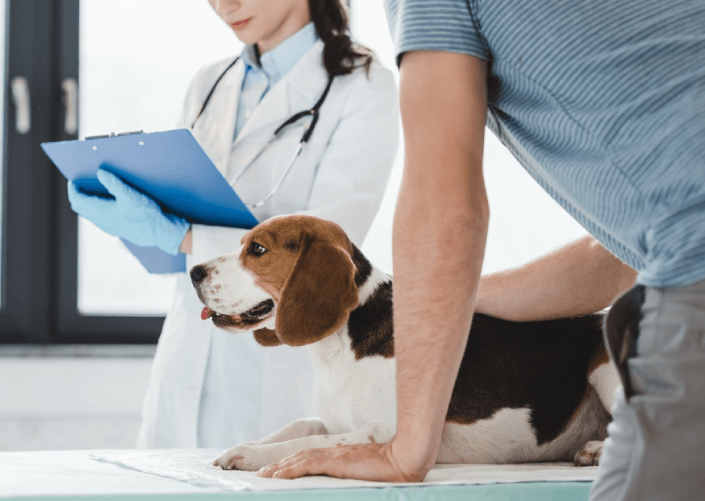Our Location
304 North Cardinal St.
Dorchester Center, MA 02124


Leptospirosis is a bacterial infection caused by various species of Leptospira. This zoonotic disease can affect both animals and humans, making it a significant concern for pet owners. In dogs, it often leads to severe health issues, including kidney and liver damage.
Understanding leptospirosis is crucial for early detection, effective treatment, and prevention. As a pet owner, being informed can help you protect your furry friend from this potentially life-threatening disease.
Leptospirosis is caused by different strains of the Leptospira bacteria. The most common strains affecting dogs include:
The severity of leptospirosis in dogs can range from mild to severe. It is often classified based on clinical presentation:

Early detection of leptospirosis can significantly improve treatment outcomes. Early symptoms include:
If left untreated, leptospirosis can progress to more severe symptoms:
While all breeds can be affected, some may exhibit symptoms differently due to genetic predispositions. Breeds like German Shepherds and Labradors may show more pronounced symptoms due to their active nature and larger size.

Leptospirosis is caused by the Leptospira bacteria, which can enter a dog’s body through mucous membranes or broken skin. The bacteria thrive in water and soil, particularly in warm and wet environments.
Dogs are at higher risk in environments where they might come into contact with contaminated water, such as:
Certain lifestyle factors increase the risk of leptospirosis:

If leptospirosis is suspected, a vet will perform a thorough physical examination, looking for signs of fever, jaundice, and dehydration.
Laboratory tests are crucial for confirming the diagnosis:
In some cases, imaging studies like ultrasound may be required to assess the extent of kidney and liver damage.

The primary goal of treatment is to eliminate the bacteria and manage symptoms:
Supportive care is essential to aid recovery:
Vaccination is one of the most effective preventive measures against leptospirosis. Ensure your dog receives annual vaccinations, especially if they are at high risk.
Maintain good hygiene practices to minimize the risk of infection:
Limit your dog’s exposure to potentially contaminated environments:

Consider the case of Bella, a Labrador Retriever diagnosed with leptospirosis. Her owner noticed early symptoms like fever and lethargy and promptly took her to the vet. With timely antibiotic treatment and supportive care, Bella made a full recovery.
Many dog owners have successfully managed leptospirosis with early detection and treatment. For example, one owner shared how regular vaccinations and avoiding contaminated water sources kept their dog healthy and free from leptospirosis.
Dr. Sarah Johnson, a renowned veterinarian, emphasizes, “Prevention through vaccination and avoiding high-risk environments is key to protecting your dog from leptospirosis.”
Veterinary experts recommend regular health check-ups and staying informed about leptospirosis, especially if you live in areas prone to outbreaks.

Leptospirosis can lead to severe health complications if not treated promptly:
Chronic leptospirosis can significantly affect a dog’s quality of life, causing long-term health issues and reducing their overall well-being.
Effective home care is crucial for managing leptospirosis:
Long-term management includes regular veterinary check-ups and adhering to prescribed treatments. Maintain a healthy lifestyle for your dog to support their immune system.

If you suspect your dog has leptospirosis:
Seek veterinary help if your dog shows symptoms like:

My dog Max showed signs of leptospirosis with a high fever and vomiting. Acting quickly, I took him to the vet for a thorough examination.
Following the vet’s advice, I ensured Max received the necessary antibiotics and supportive care. Regular check-ups and strict hygiene practices helped in his recovery.
To prevent leptospirosis:
Maintain a clean living environment and monitor your dog’s health regularly. Consult your vet for advice on diet and exercise.

Many myths surround leptospirosis, such as the belief that only rural dogs are at risk. In reality, urban dogs can also contract the disease.
Understanding the facts about leptospirosis can help in its prevention and management. For instance, vaccination is effective, but it doesn’t provide 100% immunity, highlighting the importance of comprehensive preventive measures.

Leptospirosis is a serious bacterial infection that can have severe health implications for dogs. Early detection, prompt treatment, and preventive measures are essential in managing this disease.

As a responsible pet owner, staying informed and proactive about your dog’s health can make a significant difference. Regular veterinary care and preventive practices are key to keeping your dog safe from leptospirosis.
